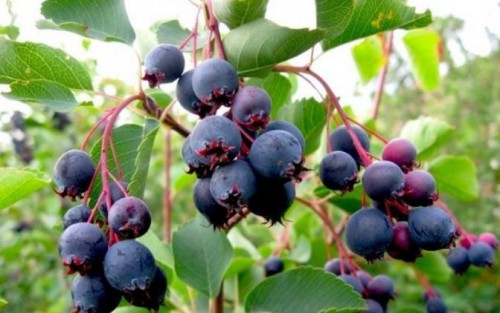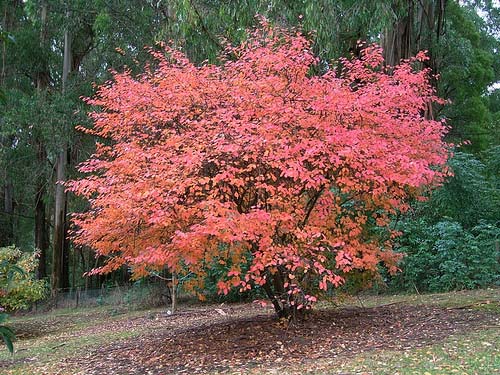Saskatoon is not very popular among gardeners, and yet it is all good, when in bloom - a feast for the eyes, there are fruit - looks decorative, and in autumn plumage - it is simply exquisite aristocrat. And all this combined with the marvelous adaptability in any soil, with drought resistance, rapid growth, hardiness and early appearance of fruit, but the main thing: fruits without rest. And how many vitamins in it! On irge, its varieties, cultivation and planting rules will be discussed in this article.
Content
Short description
Here's what you can say about irge in a few words:
- it is growing rapidly. By the 8th and data - it is already quite mature, and productive plant;
- 10-year yields up to 14 kg of fruit;
- durable. Able to live up to 70 years, of which up to 30 fruits.
Saskatoon. Grades and Features
Amelanhier, and it is the second name irgi, can be seen as a small tree or shrub, reaching a height of up to 7 meters. It all depends on the variety. A total of 25 known and all are edible. In our gardens grow mainly varieties such irgi:
- ordinary or rotundifolia. It just grows a little tree or shrub in the form of no more than 3 meters. Her straight, not thick stems branch is weak. Characterized by whitish below, and dark green top leaves egg-shaped. During flowering inflorescence covered with white tassels. Delicious and beautiful fruit - dark purple to black, sweet pea. The number of such brushes in the peas is 12 pcs. The first ripe berries appear in June, and then fruiting lasts all summer. This variety is the most popular in our country. In the photo Saskatoon varieties common in the summer;
- canadian. Tallest. There are 18-meter instances. Canadian Crohn irgi unusually pictorial. It consists of a thin, slightly drooping shoots. Its birthplace: the northeast North America. The taste of the fruit is gorgeous: gentle, sweet, juicy. During the year, gaining 25 cm in size and height. large fruit. It looks like the fall of the Canadian saskatoon, which you can see the photo below;
- pigweed. The plant is almost the same as an ordinary Saskatoon, only it matures before 10 days and grows up to 5 m Her old branches dark gray, while the young -. Brown, slightly reddish. In the spring, at blooming, leaves white fluff covers, and then they gradually become green and autumn decorates their orange and red. That's how it looks in all seasons:
How to plant and grow to be
It is believed that Saskatoon will grow on soils of any composition and care is not particularly necessary for it. This is so, but the landing irgi compliance with the rules and the result will give the best:
- just sticking irgi seedling in the ground, the harvest will have to wait a long time, and on the loose, breathable with humus soil, within 3 years will see the result;
- irgu thrown both in spring and fall;
- irgi plants love the sun, but not direct its rays. The place should be with a light shading. In the shadow of a strong crop will get the same, but a little, and the sun threatened her burns;
- minimum size of the hole for planting, even at very shallow planting - 0,6h0,6 m;
- if planned landing several plants, the pit from the pit must be located at a distance of about 2 meters. In the case of tabs of the second row, it is necessary to depart from the first 4 m. When out irgi supposed to create a hedge, the distance between the plants is reduced to 1 m, and the appearance of a solid crown, bushes after one removed. In order for a family of 4 to provide vitamins, enough to a maximum of 2 plants;
- it is necessary to put ash and the organic in the pit for planting. If there are no organic fertilizers, minerals will be replaced: phosphoric and potash in a 2: 1 ratio.
How to increase landing Irgi
If you are already growing on the Irga plot, you can multiply it. Methods are several:
- planting seeds. Sit in the fall in a fertilous and wet soil, as well as in the spring, but then they must be previously stated for 3 months, placing seeds into wet sand and lowering the box to the basement. In place where IRGA will grow constantly, seedlings are transferred in 2 years. The variety is not preserved at this breeding method;
- cuttings, which are cut in summer from bushes at least 5 years and is preferably not older than 6. The best length of the cutlets is 10-15 cm. The leaves are removed from them, except for the 3rd of the top. From 6 to 12 hours they are kept in the root. After the cuttings are washed and planted in a greenhouse, slightly tilting. After rooting, they are frowning in a reserved place, and already on the next fall they are ready for landing for a permanent place;
- root pig, and both in the fall and spring. The pigs are simply separated and soldered on a highlighted area;
- replanting a plant, a bush divide;
- we put on an ordinary rowan, more precisely, on her 2-year-old sighter and a hawthorn. This method is used very rarely;
- digging. Choose a young escape, pinch the top, laid it into a pre-prepared groove and fix it. 1/2 Part of the rustling shoots are plugged several times fertile soil. Best of all the separation of the tank to do in the spring.
Care for Irgoy
As for further care, it also has its own requirements, the execution of which will contribute to getting a good crop.
How and when to trim
If you believe the statement that Irw care does not require, then after some time the berries will be less and less and they will become small. And this will happen because without care poorly all plants, even so undemanding as Irga. It also needs to be rejuvenated.
Young saplings
If the small seedlock of Irgi is planted, then:
- in the spring we reveal what shoots have grown over the previous year;
- shoots that have grown out of the ground, i.e. Shoot the zero order, we leave until the plant will be 3 years old. Further we delete them, leaving only 2-s. The correctly formed bush of IRGI has 10-15 pcs. Escapes.
Full bush
At the generated bush annually:
- We remove damaged and weak branches;
- we destroy the excessive root pig, leaving from 10 to 20.
Care for old bush
It is necessary to rejuvenation with an old bruise, so:
- Old branches cut out than we provide the growth of new;
- the main branches are shorter up to two meters. So more convenient to collect ripe berries Irgi.
Drought-resistant and unpretentious irge watering and feeding will not interfere
To ensure a good crop, you need to remember that:
- when berries are poured, especially in summer, dry and sultry, Irga needs abundant and periodic watering;
- in the spring and autumn the soil around Irgi loose;
- 3 years after landing do not allow the growth of weeds around the bush;
- when there is a lot of fruits on a young plant, tapping the branches so that they do not crumble;
- removed harvest from 2 to 3 times per season;
- because IRGA is fruit annually, it takes a lot of nutrients from the soil, and hence it is necessary to fertilize it regularly.
Than when and how to feed
IRGU feed on the 2nd year:
- in the spring, they make humus in a roar zone and loose or poured a solution of organic fertilizers;
- in the autumn, the soil is drunk around the bush and complete mineral fertilizer contribute;
- in the summer, when the bush is poorly in growth, it will help chicken litter or a solution of a cowhouse at a concentration of 1:10. If you get the body problem, then replace it with ammonium nitrate.
Irgi's defense
IRGA, the cultivation of which does not require ease of natural effort, needs to be protected. Many pests on it will not settle, but there are also those who are able to inflict a significant damage to the tree. It:
- currant leaflet. Destroy it with a carbofos and such an insecticide, like accomplish;
- mol Pestry. Effectively struggle with her entomophages - predatory bedbugs and zlatg-paragraphs;
- love the game and birds. Waving her more brilliant tinsel on it, you scare them.
Here's how to collect and use IRGU in Canada:
























